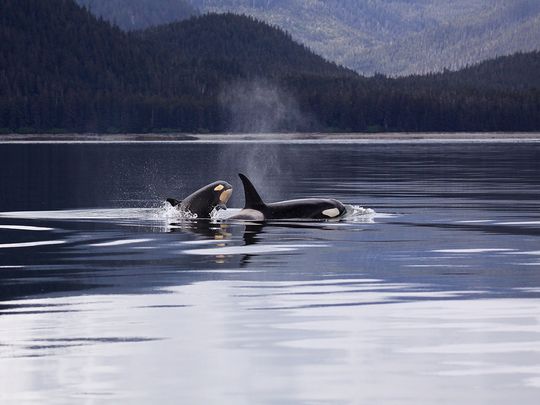
At the top of the food chain in the ocean, orcas or killer whales are truly successful creatures, and there’s one main reason for it: they’re incredibly clever.
Click start to play today’s Spell It, where we discover ‘illumining’ facts about these majestic marine animals.
Orcas were in the news recently when they displayed new behaviours that shocked the scientific community. But orcas have always been known for their intelligence. Here are some examples, according to an October 2023 report in the US-based science news website LiveScience:
1. They are social learners
Humans aren’t the only creatures to get caught up in fads. Orcas have been known to adopt temporary behaviours started by one or two individuals, and then swiftly abandon them. For instance, an orca population in the Pacific wore salmon as hats in the 1980s. According to a 2004 review published in the journal Biological Conservation, the trend began when a female orca began hoisting a dead salmon on her head. Others noticed, and the behaviour spread to two other pods in the community. It happened again the next year, and ever since then, the practice has completely disappeared. Some experts think the recent orca attacks on boats in Europe may also be an example of a killer whale fad.
2. They have greeting ceremonies
Orcas take part in complex social rituals. For instance, they often line up in two rows and them tumble together, according to an August 2011 report in the Smithsonian Magazine. On one occasion, in 2020, in the Strait of Juan de Fuca, on the border of the US and Canada, a pregnant female produced a calf in such a ceremony, while orcas belonging to three pods lingered around her just to socialise on the day of the birth, with clicks and whistles.
3. They seem to have friends
In a 2021 study in the journal Proceedings of Royal Society B, it was unearthed that killer whales interact more with certain members of their pod than others – and the group is usually of a similar age and gender. It’s also common to see a pair of orcas always together, sharing a bond that’s uncannily similar to human friendship.
4. They have distinct dialects
Orcas live in pods that relate to their mothers and their descendents. Each pod has its own unique calls, like the different dialects of the same language. Orcas have also been known to be able to mimic new sounds, which likely helps them form their dialects. At the Marineland aquarium in Antibes, France, researchers were even able to teach a 14-year-old captive orca named Wikie human words, like ‘hello’ and ‘good bye’, as well as the sounds of other animals. Wikie was so clever, she picked up the sounds quickly and even reproduced some new sounds on her first attempt.
5. They once hunted whales with humans
For around 1,000 years, off the coast of Australia, a population of orcas hunted with Indigenous people, and later, European whalers. They would hit the water to alert humans to the presence of whales in the area, and would even tow boats to the right location with a length of rope. For their assistance, humans gave the orcas whales’ lips and tongues, which is why it became known as the ‘Law of the Tongue’. The practice held until the 1930s, when commercial whaling destroyed the population of baleen whales.
What do you think of these extraordinary abilities of orcas? Play today’s Spell It and tell us at games@gulfnews.com.



